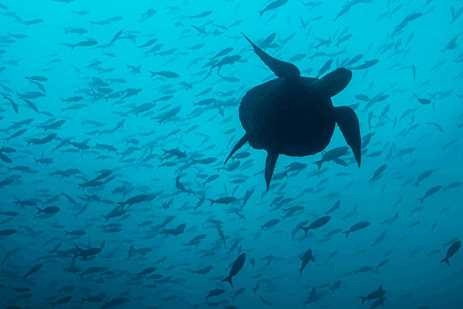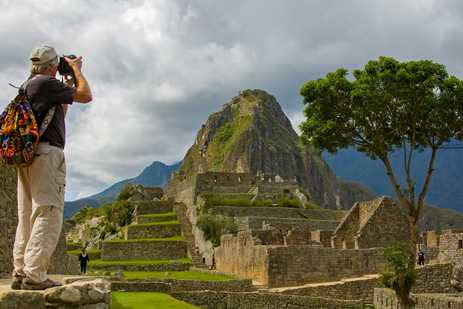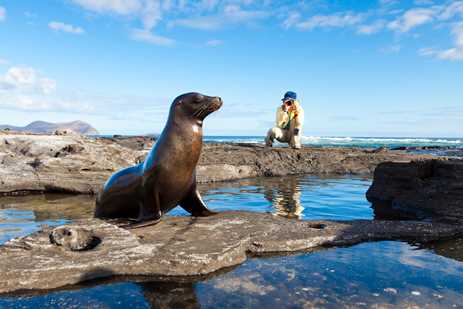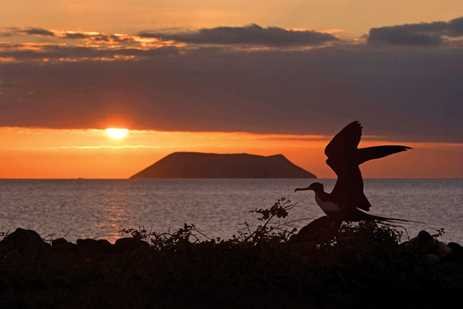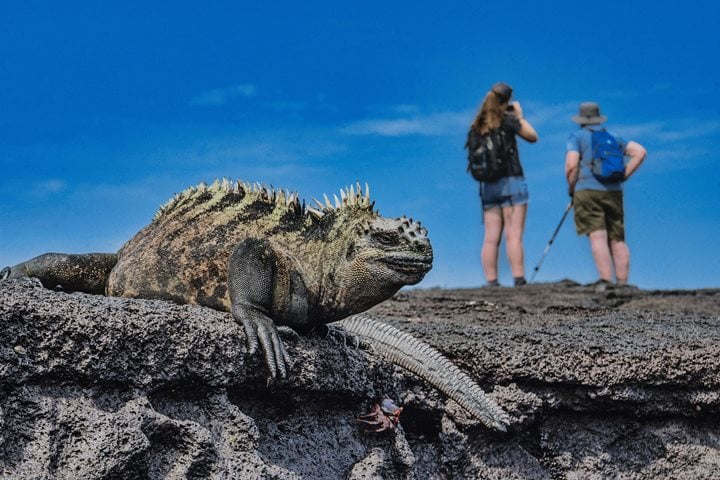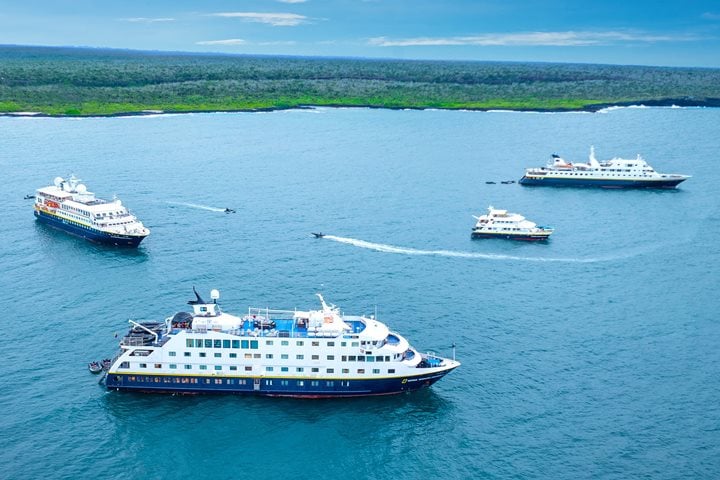Call +1.800.397.3348 or contact your travel advisor
One of our planet’s most protected places, the untamed and isolated Galápagos Islands are vastly different from any other vacation destination. Galápagos National Park comprises 97% of the archipelago and its surrounding waters make up one of the world’s largest marine reserves.
To ensure that the curious creatures and fragile ecosystems in this legendary destination continue to thrive, tourism in Galápagos is a carefully regulated privilege. There are only two ways to visit: a live-aboard cruise that sails between islands or a land-based tour on one of the four inhabited islands.
Read on to discover the pros and cons for both types of trips and the most important questions to consider before you decide.
What’s the Best Way to See the Galápagos?
In Galápagos, travelers on cruises as well as on land-based tours are only permitted into established visitor sites—70% of which can only be reached by ship. That means cruises are really the best way to see Galápagos.
The archipelago’s natural treasures are scattered across more than 23,000 square miles of Pacific Ocean, and each of its 19 major islands reveal their own wild personalities and distinct ecosystems.
You can visit some islands by day boat, but it is simply not the same as sailing all through the archipelago. To really experience the Galápagos and its awe-inspiring biodiversity, you’ll want to explore as many islands as you can, and the bottom line is you’ll have to work much harder to do that if you choose a land tour.
Deciding Between a Galápagos Land Tour vs. Cruise
Since the majority of visitor sites can only be accessed by ship, travelers staying on land will be limited in their itineraries. Island access is a key differentiator between ship and land-based trips, but there are many more factors that might impact your decision. Ahead, we highlight more pros and cons of both kinds of trips, and how to determine which is right for you.
Pros and Cons of a Galápagos Cruise
Pros of a Galápagos Cruise
- Reach the most remote islands and have them practically all to yourself
- See a greater variety of Galápagos animals, including more chances to spot marine life
- All-inclusive accommodations, meals, and excursions
- Some cruises provide adventure equipment like kayaks or snorkel gear
- No need to pack and unpack every few days
- Expert guides and naturalists on board, many of whom are from Ecuador
- Maximize your time exploring since the ship travels at night
- Enjoy incredible stargazing away from the noise and lights of town
- Sparse cell service at sea encourages quality time with loved ones
- Kitchen staff can cater to food allergies and sensitivities
- Onboard medical care in case of emergency
Cons of a Galápagos Cruise
- More expensive on average
- Privacy is limited to your cabin
- Fixed itineraries mean travelers must stick to the ship’s schedule
- Seas can be choppy—more of a concern for yachts and catamarans than expedition ships
- The Park Service prohibits ships from revisiting a site within 15 days
- Highly active—not the best choice if you’re only looking to relax or sit on the beach
Touring the Galápagos Islands on a Small-Ship Cruise
The largest vessels permitted in Galápagos are tiny in comparison to some of the megaships sailing in the Caribbean and Mediterranean. National Park regulations limit ships to just 100 passengers, and the smallest hold as few as 16, which is the maximum amount of people one naturalist guide can legally supervise.
Traveling aboard a small ship provides a more intimate experience that comes with some wonderful benefits. For example, you can develop rewarding relationships with your guides and crew, as well as with your fellow passengers, which is much harder to do on day trips.
Cost of a Galápagos Cruise
Galápagos cruises average around $1,000 per day. At first glance, this may seem pricey, but it provides an all-inclusive pass to a remote, once-in-a-lifetime destination. Additionally, cruise pricing will sometimes also include flights from mainland Ecuador, transfers, park fees, permits, and tourist cards.
While you can find some budget cruises costing as little as $2,000, they tend to be much more limited in scope and offer the bare minimum when it comes to accommodations and creature comforts.
Is a Galápagos Cruise Worth It?
Ask anyone who has explored the islands on an expedition cruise and odds are they will say a resounding ‘yes!’ Each morning when you wake up at a different, remote landing site and head out to spot new animal species and explore new landscapes, you will absolutely find it worth it.
Here are some of the Galápagos sites you can only experience aboard a cruise along with some of the highlights at each one.
Galápagos Visitor Sites Only Cruises can Reach
- Rábida Island: red sand beach, sea lions, Galápagos warblers, flycatchers, Darwin’s finches, Galápagos hawks
- Genovesa Island: 45 endemic bird species including Nazca and red-footed boobies, Galápagos mockingbirds, frigatebirds, storm petrels
- Post Office Bay, Floreana Island: partake in a centuries-old tradition and “mail” a postcard via the wooden mail barrel
- Punta Espinoza, Fernandina Island: hundreds of marine iguanas, sea lions, flightless cormorants, sea turtles, and other marine species
- Tagus Cove, Isabela Island: Galápagos penguins, sea lions, flightless cormorants
- Urbina Bay, Isabela Island: giant tortoises, land iguanas, Galápagos hawks
- Buccaneer Cove, Santiago Island: white-tip reef sharks, rays, sea lions, and an array of colorful fish
- Port Egas, Santiago Island: black sand beach, excellent tide pooling, Galápagos fur seals, sea lions, marine iguanas
- Sullivan Bay, Santiago Island: walk along “pahoehoe” lava beds looking out for pioneer plants
- Espumilla Beach, Santiago Island: palo santo forest, green sea turtles, pink flamingoes
Pros and Cons of Galápagos Land-Based Tours
Photo: Ralph Lee Hopkins
Pros of Land Tours
- Can be more affordable than cruising
- Itineraries can begin and end on your preferred day
- More spacious lodging than small ships or yachts
- Meet more native Galapagueños
- Spend more time at museums, galleries, or historical sites
- Easier access to mountain biking, horseback riding, and other land activities
- Ability to visit the same snorkeling/dive sites multiple times
- Cell service and WiFi are more readily available; though, this may double as a con
Cons of Land Tours
- Requires buying a package or extensive research to plan tours, transportation, and accommodations
- Transit time and inter-island travel days will take up much of your trip
- Excursions and activities cost extra and are subject to availability
- Less access to wildlife near port towns
- Many of the most unique uninhabited islands cannot be reached on day tours
- Day tours often arrive at visitor sites midday, when the sun is harshest and wildlife is least active
- For those prone to seasickness, speedboat ferries are more impacted by choppy seas than larger vessels
- Hotels often offer breakfast and day tours include lunch, but meals are otherwise up to you
- Land-based visits require more infrastructure
- Those who don’t speak Spanish might struggle to communicate in more rural areas
How to Visit the Galápagos Islands Without a Cruise
To get to the Galápagos archipelago, which is more than 600 miles off the coast of Ecuador, visitors must first fly to either Quito or Guayaquil. Plan to overnight on the mainland as flights to the islands depart in the morning, for either San Cristóbal or Baltra, just off of Santa Cruz.
Santa Cruz is the island-hopping hub, and all ferries either depart from or transfer in Puerto Ayora. For example, to get from San Cristóbal to Isabela, you must disembark in Santa Cruz and potentially spend the night depending on your schedule.
There are hotel options on Santa Cruz, San Cristóbal, and Isabela, and there are limited accommodations on Floreana. Apartment and house rentals are available in all four of these inhabited islands. While the port towns offer restaurants and shops, they are not the best places to observe wildlife. You will be dependent on day tours to the nearby uninhabited islands to see Galápagos’ pristine volcanic landscapes and the fascinating flora and fauna that call them home.
The following lists show common day tours from each inhabited island and the visitor sites that are accessible by foot, bus, car, or a short dinghy ride.
Common Day Tours from Santa Cruz
- Bartolomé Islet
- Chinese Hat Islet
- Floreana Island
- North Seymour Island
- Santa Fe Island
- South Plaza Island
Land-Based Sites on Santa Cruz
- Charles Darwin Research Station
- The Highlands
- Los Gemelos (Twin Craters)
- Tortuga Bay
- Playa de los Perros
- Garrapatero Beach
- Alemanes Beach
- Las Grietas and El Mirador
Common Day Tour Sites from San Cristóbal
- Española Island
- Kicker Rock Marine Site
- Punta Pitt, San Cristóbal Island
Land-Based Sites on San Cristóbal
- Interpretation Center
- Tortoise Reserve
- Sea Lion Rookery
- Punta Carola Beach
- Cerro Brujo
- Frigatebird Hill
- Puerto Chino Beach
- El Junco Lagoon
Common Day Tour Sites from Isabela
- Tintoreras Islet
Land-Based Sites on Isabela
- Villamil Lagoons
- The Wetlands
- Wall of Tears
- Arnaldo Tupiza Breeding Center
Land-Based Sites on Floreana
- Cerro Alieri
- Asilo de la Paz
The Downsides of Visiting the Galápagos on Your Own
Land-based trips certainly do offer more independence and flexibility, but not as much freedom as you might think. First, due to limited operating schedules, you’ll lose several days to travel.
All planes arrive from and depart for mainland Ecuador in the morning, which is also when the day tours begin, so the first and last days of your trip will be quite limited.
Inter-island travel will also take up a day each time you “island hop.” You’ll need to adhere to public ferry schedules, which have only two departures: early morning and afternoon.
Ferries take about two to three hours depending on sea conditions and passengers are asked to arrive one hour prior to departure, which will make it complicated to visit sites on those days, as well. Puddle jumper flights are also an option, but fares tend to be costly and your luggage can't weigh more than 25 pounds per person.
From an environmental perspective, increased independent travel to this fragile ecosystem has consequences. Because land tours are not yet as closely monitored as cruise ships, it’s incredibly important to do your research on sustainable tourism best practices before you go. For example, some travel bloggers may even report that folks can explore certain visitor sites without a National Park-certified guide, but it is highly advised against doing so.
Questions to Help you Decide: Cruise vs. Land Tour
There is an array of factors to consider when planning to explore these legendary islands and we’ve covered many of them above. However, if you’re still not sure, here are a few more key questions to help determine which method best suits your idea of a Galápagos dream trip.
Which Wildlife Are You Most Excited to See?
Can’t wait to swim alongside the marine life? Live-aboard cruise itineraries include legendary snorkeling spots where you can swim with endemic Galápagos penguins, sea lions, sharks, marine iguanas, sea turtles, and myriad, colorful fish.
While you’re cruising around the islands, you’ll also have the chance to spot larger marine species at sea like pods of dolphins, killer whales, sperm or blue whales, or if you’re lucky even the unique-looking ocean sunfish. If you’re a passionate birder, keep in mind some islands like Genovesa (known as “Bird Island”) can only be reached on a cruise.
On a land-based tour, wildlife you can reliably encounter include giant tortoises, marine iguanas, sea lions, and various sea and shorebirds—though not necessarily up close. Hiring naturalist guides and taking day tours to visitor sites will increase your chances of seeing more of the archipelago’s iconic species.
How Flexible Is Your Schedule?
If you only have four or five days to spend in Galápagos, a cruise will undoubtedly make the most of your time.
However, if you have a strict vacation schedule, cruise departures may not line up, whereas a land-based tour will offer more flexibility in duration and itinerary. Staying on land, you will need at least a week for the trip to be worth it. Make sure to book as much as possible in advance; Hotels, day tours, and even ferries have limited availability.
What Are Your Preferred Activities?
The most memorable trips to Galápagos are determined not only by what you see, but how you see it. Expedition cruises will offer the widest variety of activities and stock a range of state-of-the-art adventure equipment like snorkeling gear, kayaks, stand-up paddleboards, Zodiacs, and even glass-bottomed boats.
Activities that are more accessible on land include mountain biking, horseback riding, camping, hiking, and surfing. Scuba diving is also easier to book from land unless you choose a dedicated diving cruise. Keep in mind: water temperatures can drop down to the 60s, and currents can be quite strong. December through May will have the warmest water. You may also opt to visit museums, shop in town, or relax on the beach.
As you continue to compare the perks of setting sail versus hotel hopping, take your time. Galápagos is one of the world’s greatest adventures, but it’s no place for urgency. That might mean waiting until you’ve saved up enough money to take your dream trip—but once you are there standing among the animals, it will all be worth it. It’s also key to do the proper research that will lead to responsible decisions. The Galápagos is a most unusual and special destination and visiting with care is what will help to preserve as many of its wonders as possible for centuries of travelers to come.





